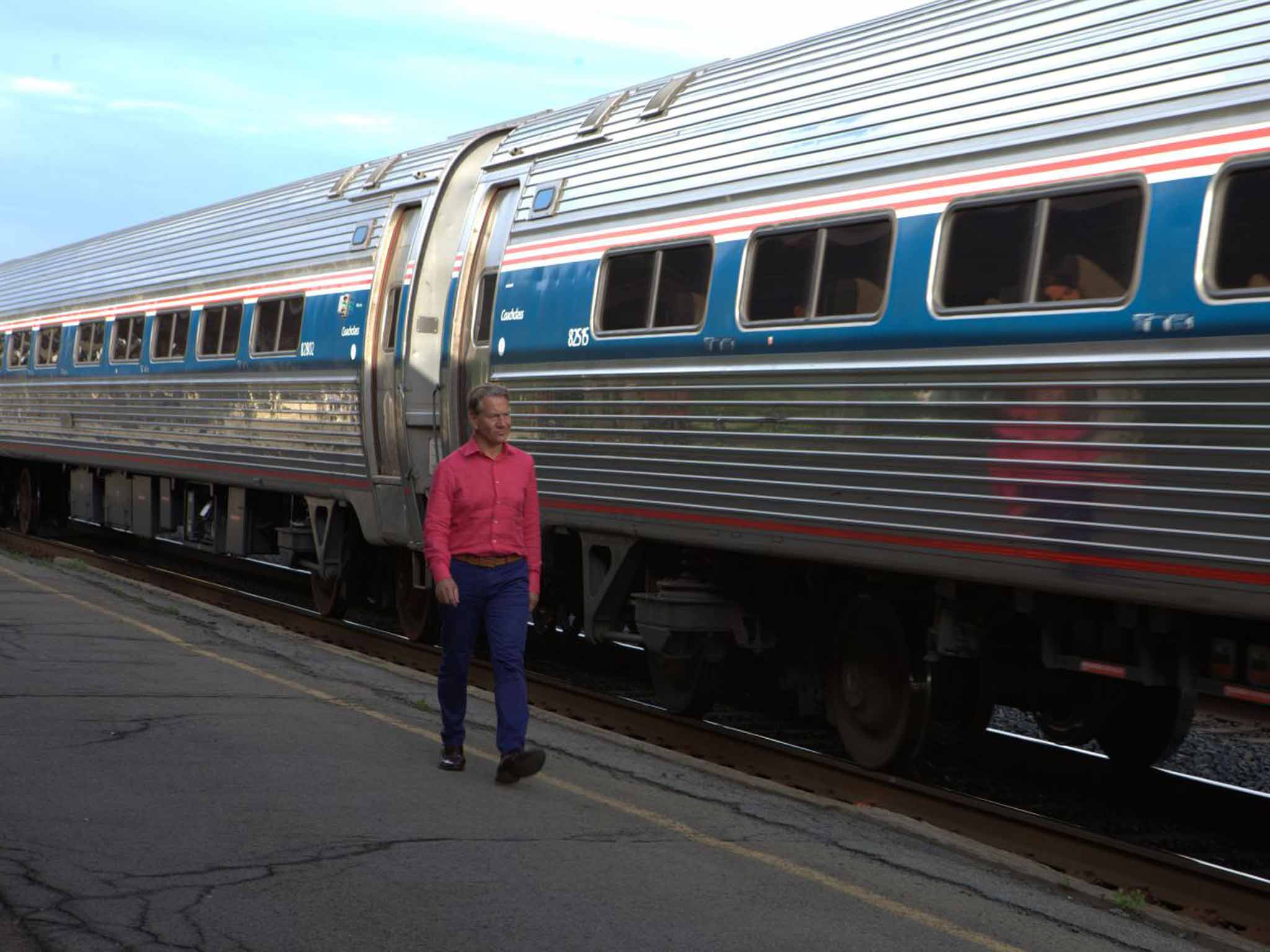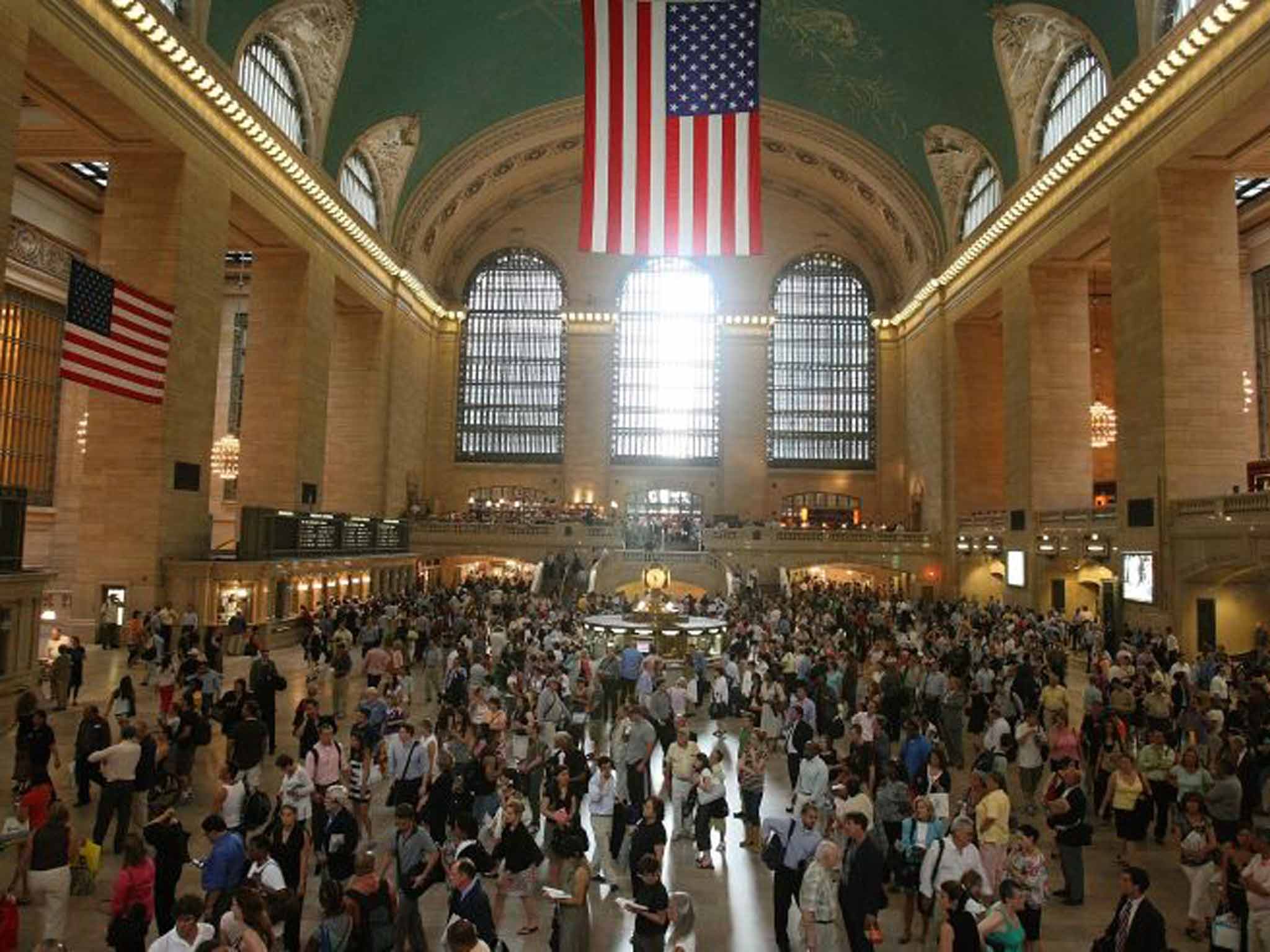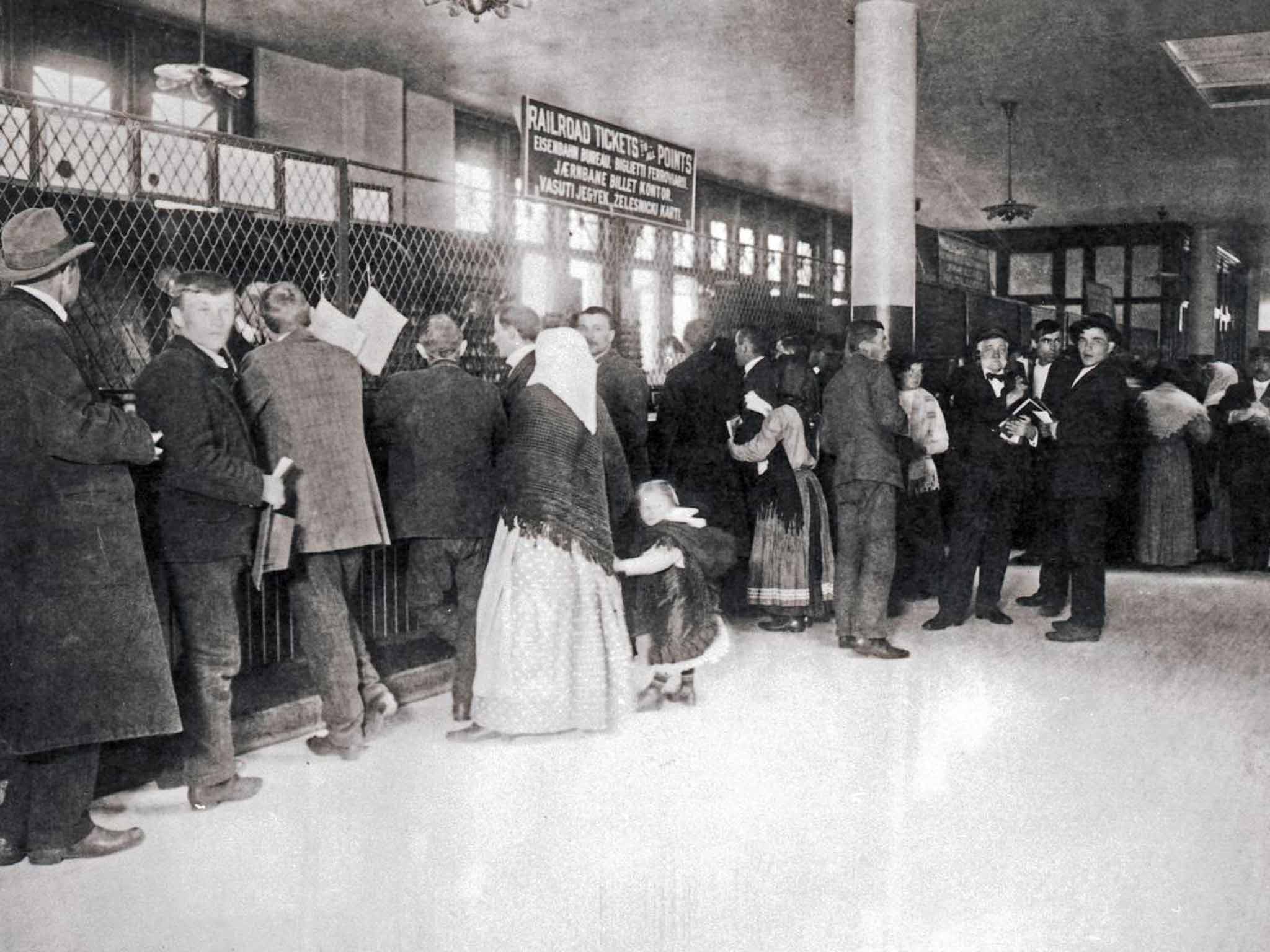Great American Railway Journeys: Michael Portillo rides once mighty railroads from New York to Virginia
The tracks that united a vast and varied nation, running past Gilded-Age mansions and historic landmarks

Your support helps us to tell the story
From reproductive rights to climate change to Big Tech, The Independent is on the ground when the story is developing. Whether it's investigating the financials of Elon Musk's pro-Trump PAC or producing our latest documentary, 'The A Word', which shines a light on the American women fighting for reproductive rights, we know how important it is to parse out the facts from the messaging.
At such a critical moment in US history, we need reporters on the ground. Your donation allows us to keep sending journalists to speak to both sides of the story.
The Independent is trusted by Americans across the entire political spectrum. And unlike many other quality news outlets, we choose not to lock Americans out of our reporting and analysis with paywalls. We believe quality journalism should be available to everyone, paid for by those who can afford it.
Your support makes all the difference.Grand Central Terminal in New York City is a railway temple. I cannot think of a better place to begin a journey of discovery, hoping to understand how the railroads made the United States.
As I cross Grand Central's vast main concourse, I gaze upwards to search for Orion, Gemini and Taurus on the painted astronomical ceiling suspended 125 feet above me. From a high walkway that passes behind the station's cathedral windows, I can look down on the miniaturised crowds scurrying towards their allocated track, or gathering around the fine four-faced clock of the information booth.
A recurrent theme in the terminal's lavish decoration is the acorn, borrowed from the crest adopted by the Vanderbilt family. The founder of the dynasty's fortune, Cornelius, left school at 11 and became the second-richest man in American history, through investment in shipping and railroads. When the tracks running north from Grand Central were put into a tunnel, the Vanderbilts created Park Avenue and made a further fortune from constructing some of the world's most exclusive real estate.
The late 19th century in the US produced what Mark Twain dubbed a “gilded age”. The expansion of the railroads, whose track mileage tripled between 1860 and 1880, was the main driver. Andrew Carnegie, born to poor parents in Dunfermline, Scotland, made a fortune investing in rail stocks, and then manufacturing steel rails at a time of frenzied demand.
There were tycoons aplenty, and in the early 20th century many flaunted their wealth in stately homes on Long Island's so-called gold coast. The first rail and ferry connection between Boston and New York produced tracks running the length of Long Island. When a faster route through Connecticut opened, investors scrambled to convert the redundant Long Island Railroad into a line serving new mansions and suburbs.
I take the LIRR to visit Oheka Castle. It's a “French château” built by the financier Otto Hermann Kahn, who had made his fortune merging railroad companies. Once the second-largest private residence in the US, today it is a hotel. There, I try to imagine the crazy profligacy and frenzied partying of the tycoons, captured in F Scott Fitzgerald's The Great Gatsby.
Nowadays the millionaires' playgrounds have shifted further along the island away from the city to Easthampton and Southampton, whose populations multiply in the summer months. Again, I take the LIRR. I suspect that the wolves of Wall Street more often travel there by helicopter.
Back in Grand Central, beneath the benches in the waiting hall, grooves have been worn into the stone floors by the millions who have passed time there since the station opened a century ago. Many were immigrants – Italians and Irish fleeing hardship and hunger, Eastern European Jews escaping pogroms – recently arrived at Ellis Island and shortly to board trains for the vast American interior.

I take the New York subway down to Battery Park and a ferry over to Ellis Island. Our boat passes the Statue of Liberty, whose torch is stretched out in welcome to the desperate migrants. “Give me your tired, your poor, your huddled masses yearning to breathe free, the wretched refuse of your teeming shore,” wrote Emma Lazarus in a poem which since 1903 has been inscribed on a plaque at the statue. In a single year the island processed more than a million entrants.
The Great Hall at Ellis Island is, like Grand Central, a huge space opened at the start of the 20th century. It provided the first glimpse of American architecture for those millions who waited there to be deemed medically fit or unfit for admission. Some of the lucky ones might choose not to take the train from Grand Central, but to settle in Manhattan. Jacob Riis photographed their cramped and insanitary tenements; the title of his book of shocking images gave the English language an enduring phrase: “How the other half lives”.
“Tycoons and immigrants” might seem to summarise the inequalities of the US. But that would overlook how often the American dream came true. Many tycoons were immigrants, and Bob Hope from Eltham and Cary Grant from Bristol did well in America too.
I take the train along the banks of the mighty Hudson River to upstate New York, past Schenectady (where Thomas Edison arrived in 1886 to found his machine company which became General Electric) and Rochester (where George Eastman started the Kodak company in 1888). Arriving at Niagara Falls, I have a feel for the vastness of the US, since after a journey equivalent to London to Edinburgh, my progress scarcely registers on the map of the continent.
In the early part of the 19th century, some Americans feared that the country was too big to hold together. It took weeks to travel from Washington to Chicago, and months to San Francisco. Was such a vast country governable, or might it descend into chaos: warring states on the model of Europe? The railroads removed the geographical threat to unity. In 1861, the president-elect, Abraham Lincoln, could travel from his home in Springfield, Illinois, to his inauguration in the capital largely by train. After 1869, San Francisco was just six days away from New York City.
The classical columns of Philadelphia's 30th Street station provide my gateway to considering the foundation of the United States. The Liberty Bell, imported from Whitechapel in London, already hung in the Pennsylvania State House when the Founding Fathers signed the Declaration of Independence there on 8 July 1776.

Two hundred and forty years ago an exceptional group that included Thomas Jefferson, Benjamin Franklin, John Hancock and John Adams, committed itself to uplifting and enlightened ideals. “We hold these truths to be self-evident, that all men are created equal, that they are endowed by their Creator with certain unalienable Rights, that among these are Life, Liberty and the pursuit of Happiness.” Americans came to view their country as “a shining city on a hill” with a Manifest Destiny to carry its example ever further afield. Indeed, the ambitious principles of the Declaration, revolutionary in their day, inspire a hundred democracies today.
But the United States were born with a founding flaw: the original sin of slavery. Men might have been created equal but they did not live equally in America. Even Jefferson and the first president, George Washington, owned slaves. The Founding Fathers did not address the fearful contradiction, and it was to tear the United States apart after Lincoln's election in 1860.
The American Civil War was fought to preserve the Union as 11 southern states seceded to form the Confederacy. In Gettysburg, Pennsylvania, I stand on the station platform at which Lincoln alighted in November 1863. He was to speak at the dedication of the cemetery for Union soldiers killed in the battle earlier in the year. In a few words – now known as the Gettysburg Address – he called for a rebirth of freedom. Slavery would not survive victory by the North.
My journey also takes me to Manassas, Virginia. In 1861, Confederate forces had moved to block the railroad between the rival capitals in Washington, DC, and Richmond, Virginia, and to protect the junction at Manassas. Rebel reinforcements arrived by train, in what became the first railway war. For the duration of the conflict, both sides laid tracks at a frantic pace. After the war's conclusion in 1865, the railway building boom helped to tie the North and South together, physically at least.
The great stations in New York City and Philadelphia remind us that railroads created enormous wealth. But the aeroplane has almost killed off American railroads, as surely as they had once supplanted the canals. The Pennsylvania Railroad's magnificent Neoclassical station in New York was torn down in 1963 as part of a property deal. Yet it was not enough to save the company from financial collapse.
Moving south from Washington, my trains are frequently unpunctual. Some of the stations are derelict. In any case, platforms become something of a rarity down there, and at each stop passengers who are frail or encumbered by luggage have to be helped down the ladder-like steps from the train, adding to the delays.
But the train in America is not quite dead. A massive engineering project between Manhattan and Queens is redirecting the LIRR into a new subterranean terminal at Grand Central (helping passengers who presently are taken unwillingly across town to Penn station). As part of the regeneration of New York after the 9/11 terrorist attacks, a stunning new rail terminal, designed by Santiago Calatrava, is nearing completion at the World Trade Center.
It is a present day example of the resilience of the United States. Despite its enduring inequalities, during my journey it seemed to me that Americans are still fired by enviable idealism and enthusiasm. Despite falling painfully short of their founding ideals, they are still inspired by the Declaration of Independence and the Gettysburg Address to hope for better, as though their Manifest Destiny might yet overcome their manifold problems.
'Great American Railway Journeys' starts on BBC2 on Monday at 6.30pm
Visiting there
Grand Central Terminal, New York City (001 212 340 2583; grandcentralterminal.com).
Oheka Castle Hotel and Estate, Huntington, Long Island (001 631 659 1400; oheka.com). Double rooms start at $441 (£315), room only; mansion tours cost $25 (£18).
Ellis Island, New York (001 212 561 4588; libertyellisfoundation.org). Tickets to the museum, including ferry transport from New York, from $18 (£13).
Long Island Railroad (mta.info/lirr).
More information
Join our commenting forum
Join thought-provoking conversations, follow other Independent readers and see their replies
Comments